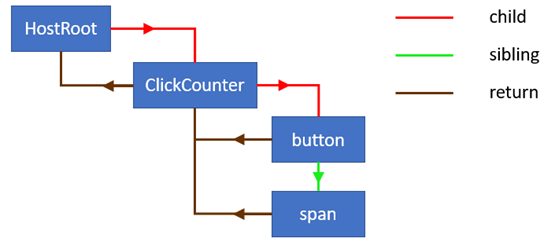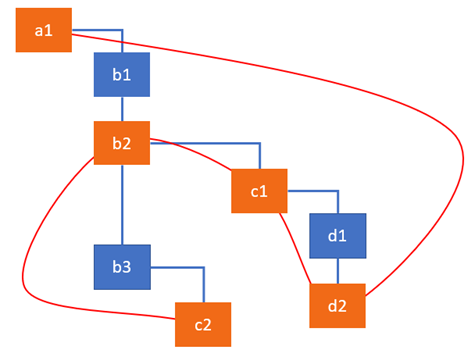Fiber 的相关概念
Fiber
React 为每一个元素都创建了一个 Fiber 节点,最终组成一颗 Fiber 树,

Fiber 是一个链表结构,child 指向第一个子节点,sibling 指向下一个兄弟节点,return 指向父节点。
function FiberNode(
tag: WorkTag,
pendingProps: mixed,
key: null | string,
mode: TypeOfMode,
) {
// 实例
this.tag = tag;
this.key = key; // 一组子节点的唯一标识符
this.elementType = null; // element.type
this.type = null; // 指向组件的函数、构造函数、DOM 节点的 HTML tag
this.stateNode = null; // 对组件、DOM节点或与光纤节点关联的其他元素类型的类实例的引用
// Fiber 引用
this.return = null; // 父节点
this.child = null; // 第一个子节点
this.sibling = null; // 下一个兄弟节点
this.index = 0;
this.ref = null;
this.pendingProps = pendingProps; // 根据React元素中的新数据更新的 props,需要应用于子组件或DOM元素。
this.memoizedProps = null; // 在上一次渲染期间用于创建输出的 fiber props
this.updateQueue = null; // 状态更新、回调和DOM更新的队列。
this.memoizedState = null; // 用于创建输出的光纤的状态。处理更新时,它会反映屏幕上当前呈现的状态。
this.dependencies = null; // 依赖项(上下文、事件)(如果有)
this.mode = mode; // 描述 fiber 及其子树属性的位字段。
// 副作用
this.flags = NoFlags; // 副作用标识,以前叫做 effectTag
this.subtreeFlags = NoFlags;
this.deletions = null;
// 任务批次
this.lanes = NoLanes;
this.childLanes = NoLanes;
this.alternate = null;
}
Fiber tree root
React 为每个容器创建一个 fiber root。源码中一般是 HostRoot
workInProgress
第一次渲染过后,React 最终会生成一颗 Fiber 树。这棵树通常在源码中叫做 current(首次渲染中 current 为 null)。
当 React 开始处理更新时,React 会生成一颗 workInProgress 树。
所用工作都在 workInProgress tree 的 Fiber 上执行,一旦整棵树更新完并在屏幕上呈现,他就变成了 current。
React 总是一次性更新 DOM,不会显示部分结果,workInProgress tree 充当着不可见的中间过程。
副作用(side-effect)
在 react 中,所有组件可以视为 (state, props) => UI。
执行过数据获取、订阅或手动更改React组件的DOM,我们称之为副作用,简称 effect。大多数的 state、props 更新都将导致副作用。
应用副作用可以认为是一个工作(work)。一个 fiber 节点是一个很方便的机制去跟踪更新的 effect。
注:现在使用flags 属性标识的(以前这个属性名叫 effectTag)
Effects list
需要注意的是 effects list 已经被重构了,详见 Effects list refactor
如果在 wip 树上递归找要更新的节点会比较慢,react 提供了一个线性的数据结构 effect list,每一个元素都是需要更新的节点。
如下, effects list 会跳过不需要更新的节点。

